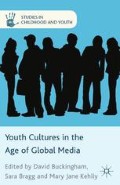Abstract
The rapid process of globalization has led to an increase in transnational cultural practices among young people who are ‘using global resources to deal with local conditions’ (Wise, 2008, p. 63). In particular, alternative popular cultural resources made available through transnational digital technologies allow young people to negotiate the symbolic and geographic boundaries of the nation state. In this regard, youth cultural studies need to acknowledge the emerging ‘youthscape’ (Maira and Soep, 2004), in which imagined places and people are integrated into young people’s lives. The evolving global youthscape, however, does not necessarily promise young people enhanced freedom and mobility; instead, it often involves particular power struggles in which young people’s lives are constrained by the intersection of global, national and local forces.
Access this chapter
Tax calculation will be finalised at checkout
Purchases are for personal use only
Preview
Unable to display preview. Download preview PDF.
References
Bennett, A. (1999). Subcultures or neo-tribes? Rethinking the relationship between youth, style and musical taste. Sociology, 33(3), 599–617.
Bennett, A., and Kahn-Harris, K. (eds). (2004). After subculture: Critical studies in contemporary youth culture. London: Palgrave.
Cho Han, H. (2000). “You are entrapped in an imaginary well”: A feminist critique of modernity and Korean culture. Inter-Asia Cultural Studies, 1(1), 49–69.
Chua, B. H. (2004). Conceptualizing an East Asian popular culture. Inter-Asian Cultural Studies, 5(2), 200–221.
Fiske, J. (1992). The cultural economy of fandom. In L. A. Lewis (ed.). (1992), The adoring audience: Fan culture and popular media (pp. 30–49). London: Routledge.
Fung, A. (2007). Intra-Asian cultural flow: Cultural homologies in Hong Kong and Japanese television soap operas. Journal of Broadcasting & Electronic Media, 51(2), 265–286.
Han, S-H. (2001). Consuming the modern: Globalization, things Japanese and the politics of cultural identity in Korea. In H. Befu (ed.), Globalizing Japan: Ethnography of the Japanese presence in America, Asia and Europe (pp. 194–208). London: Routledge.
Hills, M. (2002). Fan cultures. London: Routledge.
Hu, K. (2005). The power of circulation: Digital technologies and the online Chinese fans of Japanese TV drama. Inter-Asia Cultural Studies, 6(2), 171–186.
Iwabuchi, K. (2002). Recentering globalization. Durham: Duke University Press.
Iwabuchi, K. (2010). Undoing inter-national fandom in the age of brand nationalism. Mechademia, 5(1), 87–96.
Jeon, J. (2007, March 21). Midjok, ildjok, bidjok … Which jok do you belong to? Munhwa Ilbo, p. 28.
Jin, D. Y. (2010). Korea’s online gaming empire, Cambridge, Massachusetts: MIT Press.
Kang, J. S., Kang, Y. G. and Kim, M. C. (2012). Internet fansubbing culture: An in-depth interview study with foreign film and TV show fansubbers. Korean Journal of Broadcasting Studies, 26(1), 7–42.
Kim, D. and Won, Y. (eds). (2008). Americanization: The Americanization of Korea since the liberation. Seoul: Purun Yeoksa.
Kim, H-M. (2003). The inflow of Japanese pop culture and the historical construction of fandoms in South Korea. Korean Journal of Cultural Anthropology, 13(1), 149–186.
Lee, D-H. (2002). Media discourses on the other: Japanese history textbook controversies in Korea. Proceedings of the Media Ecology Association, 3. Retrieved from http://www.media-ecology.org/publications/MEA_proceedings/v3/Lee03.pdf
Lee, D-H. (2006). Transitional media consumption and cultural identity: Young Korean women’s cultural appropriation of Japanese TV dramas. Asian Journal of Women’s Studies, 12(2), 64–87.
Maffesoli, M. (1996). The time of the tribes: The decline of individualism in mass society. London: Sage.
Maira, S. and Soep, E. (eds). (2004). Youthscape: The popular, the national, the global. Philadelphia: The University of Pennsylvania Press.
Monteiro, A. and Jayasankar, K. P. (2000). Between the normal and imaginary: The spectator-self, the other and satellite television in India. In I. Hagen and J. Wasko (eds), Consuming audiences? Production and reception in media research (pp. 301–321). NJ: Hampton Press.
Moon, S. (2005). Militarized modernity and gendered citizenship in South Korea. London: Duke University Press.
OECD (2012, July 18). OECD broadband portal, Retrieved from http://www.oecd.org/sti/broadbandandtelecom/oecdbroadbandportal.htm
Otmazgin, N. K. (2008). Contesting soft power: Japanese popular culture in East and Southeast Asia. International Relations of the Asia-Pacific, 8(1), 73–101.
Park. J. (2007). A study on broadcast professionals’ and researchers’ perceptions of lifting the ban on Japanese broadcast programs. Korean Journal of Cultural Policy, 19, 245–265.
Pariser, E. (2011). The filter bubble: What the Internet is hiding from you. New York: Penguin Press.
Pilkington, H. and Johnson, R. (2003). Peripheral youth: Relations of identity and power in global/local context. European Journal of Cultural Studies, 6(3), 259–283.
Terranova, T. (2000). Free labor: Producing culture for the digital economy. Social Text, 18(2), 33–58.
van Dijck, J. (2009). Users like you? Theorizing agency in user-generated content. Media, Culture & Society, 31 (1), 41–58.
van Dijck, J. (2012). Facebook as a tool for producing sociality and connectivity. Television and New Media, 13(2), 160–176.
Wise, J. M. (2008). Cultural globalization: A user’s guide. New York: Wiley Blackwell.
Yoon, K. (2010). The representation of mobile youth in the post-colonial technonation of Korea, S. Hemelryk, T. D. Anderson, and D. Spry (eds). Youth, society and mobile media in Asia (pp. 108–119). New York: Routledge.
Zheng, K. (2011). Karaoke bar hostesses and Japan-Korea wave in postsocialist China: Fashion, cosmopolitanism and globalization. City & Society, 23(1), 42–65.
Editor information
Editors and Affiliations
Copyright information
© 2014 Kyong Yoon
About this chapter
Cite this chapter
Yoon, K. (2014). Looking East: Young Koreans Consuming Japanese Media in the Intra-Asian Youthscape. In: Buckingham, D., Bragg, S., Kehily, M.J. (eds) Youth Cultures in the Age of Global Media. Studies in Childhood and Youth. Palgrave Macmillan, London. https://doi.org/10.1057/9781137008152_8
Download citation
DOI: https://doi.org/10.1057/9781137008152_8
Publisher Name: Palgrave Macmillan, London
Print ISBN: 978-1-349-43551-7
Online ISBN: 978-1-137-00815-2
eBook Packages: Palgrave Social Sciences CollectionSocial Sciences (R0)

